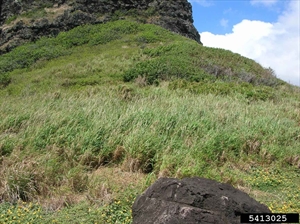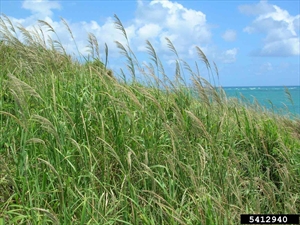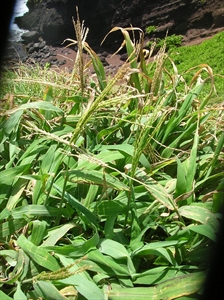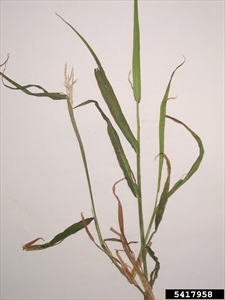Sourgrass. It is also known as cotton grass, feather-top grass.
Pacific Pests, Pathogens, Weeds & Pesticides - Online edition
Pacific Pests, Pathogens, Weeds & Pesticides
Sourgrass (498)
Digitaria insularis; previously, it was known as Trichachne insularis. It is a member of the Poaceae.
Africa (South Africa), Asia (Japan, Philippines), North, Central and South America, the Caribbean, Oceania. It is recorded from Fiji, Guam, Marshall Islands, Northern Mariana Islands, Papua New Guinea, Solomon Islands, and Vanuatu. It is native to Central and South America.
A grass of disturbed areas, forming dense stands in wastelands, roadsides, abandoned fields, pastures and forests (Photos 1&2). The grass has become invasive in regions where it is native as well as those where it has been introduced, for instance, Hawaii, Malaysia, Philippines, and Papua New Guinea. Up to 1400 masl.
Large, erect, perennial grass up to 1.5 m, branched from lower and middle nodes. Stems growing from short, swollen rhizomes. Leaves, up to 40 cm, 15 mm wide, rough at the edges, sheaths hairy, membrane between leaf and stem (ligule) 3-4 mm long. Flower clusters white or grey, somewhat closed, slender up to 30 cm, composed of up to 50 branches, each bearing many paired spikelets, 3.5-5 mm long, on stalks of different lengths, and containing the florets (flowers) (Photos 3&4).
Spread over short distances is by seed on the wind and pieces of the rhizomatous shoot base; long-distance spread is seeds attached to clothing, to camping gear, machinery and vehicles, and as a contaminant of seed of pasture species.
The grass is a problem in pastures and disturbed forests. However, there are also reports that it is an invasive weed of citrus, coffee, cotton, forest nurseries, maize, pineapple (Hawaii), and tea, although economic impacts are not well recorded. According to CABI, the grass is a host of Maize dwarf mosaic virus and Maize chlorotic mottle virus (given as MCMV - Maize chlorotic mosaic virus). Maize chlorotic mottle virus is a component of the severe maize lethal necrosis disease of East Africa. Impacts on biodiversity are reported in Hawaii with threats to native grasses.
Traditional uses include bladder and kidney ailments, as a diuretic and a dressing for wounds. Also, said to be effective against nematodes of goats. Used in flower arrangements. It is unpalatable to cattle.
BIOSECURITY
The risk of introduction of sourgrass is not clear. It is not used as a pasture grass, nor collected as an ornamental. It is unknown how it has been spread from its nature regions, but contaminant of seed lots is a possibility, particularly pasture species.
BIOLOGICAL CONTROL
Not a method recommended for Digitaria insularis.
CULTURAL CONTROL
- Physical & Mechanical:
- Dig-up seedlings. This method is less effective on plants established from rhizomes.
- Competing species:
- Plant pasture grasses, e.g., buffel grass (Cenchrus ciliaris) and Guinea grass (Panicum maximum) to compete with Digitaria insularis.
- Hygiene:
- Treat vehicles and farm machinery. If moving from areas where the weed occurs to those weed-free, wash to remove soil. This is equally important if the machinery is being imported into a country or moved within a country.
CHEMICAL CONTROL
Glyphosate. However, biotypes of Digitaria insularis are known to be resistant to glyphosate, so it is important to always use at rates recommended on the label. If necessary, use alternative products, e.g., fluazifop or nicosulfuron depending on the crop.
--------------------
Note, EU approval to use glyphosate ends in December 2022; its use after that date is under discussion.
____________________
When using a pesticide, always wear protective clothing and follow the instructions on the product label, such as dosage, timing of application, and pre-harvest interval. Recommendations will vary with the crop and system of cultivation. Expert advice on the most appropriate herbicides to use should always be sought from local agricultural authorities.
AUTHOR Grahame Jackson
Information from PIER (2013) Digitaria insularis (L.) Mez ex Ekman, Poaceae. Pacific Island Ecosystems at Risk (PIER), Institute of Pacific Islands Forestry. (http://www.hear.org/pier/species/hyptis_capitata.htm); and CABI (2019) Digitaria insularis (sourgrass). Invasive Species Compendium. (https://www.cabi.org/isc/datasheet/109596); and from Chris Brodie (2020) Weeds Australia - Profiles. Centre for Invasive Species Solutions, Department of Agriculture, Water and the Environment. Australian Government. (https://profiles.ala.org.au/opus/weeds-australia/profile/Digitaria%20insularis). Photos 1-4 Forrest & Kim Starr, Starr Environmental, Bugwood.org.
Produced with support from the Australian Centre for International Agricultural Research under project HORT/2016/185: Responding to emerging pest and disease threats to horticulture in the Pacific islands, implemented by the University of Queensland and the Secretariat of the Pacific Community.







